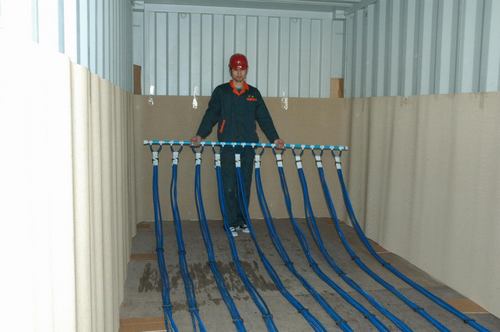HEATING PAD
The use of the heat pad is to evenly reheat the cargo before unloading. The heater pads are made to allow liquids that have a low melting point and easily solidify when subjected to low temperatures, to be discharged using either steam or hot water as a heat source.
At low temperatures, a high-viscous product would become sticky and not at all easy to discharge, therefore when transporting at low temperatures, we can install a heating pad to solve this problem. The heater pads are generally designed as a heating pad and are placed the entire length and breath of the container. The heater Pad is placed below the Flexitank (Flexibag) in order to allow maximum exposure to the heat source. The average time it takes to heat up a container of liquid is about 4-6 hours but this obviously depends on the temperature and specific heat of the actual liquid.
Maximum heat input is 124°C and maximum pressure is 300 PSI (20 Bar).

| Unit of Pressure | ||||||
|---|---|---|---|---|---|---|
| Pascal (Pa) | Bar (bar) | Technical atmosphere (at) | Standard atmosphere (atm) | Torr (torr) | Pounds per square inch (psi) | |
| 1 Pa | ≡ 1 N/m2 | 10−5 | 1.0197×10−5 | 9.8692×10−6 | 7.5006×10−3 | 1.450377×10−4 |
| 1 bar | 105 | ≡ 100 kPa≡ 106 dyn/cm2 | 1.0197 | 0.98692 | 750.06 | 14.50377 |
| 1 at | 9.80665×104 | 0.980665 | ≡ 1 kp/cm2 | 0.9678411 | 735.5592 | 14.22334 |
| 1 atm | 1.01325×105 | 1.01325 | 1.0332 | 1 | ≡ 760 | 14.69595 |
| 1 Torr | 133.3224 | 1.333224×10−3 | 1.359551×10−3 | ≡ 1/760 ≈ 1.315789×10−3 | ≡ 1 Torr≈ 1 mmHg | 1.933678×10−2 |
| 1 psi | 6.8948×103 | 6.8948×10−2 | 7.03069×10−2 | 6.8046×10−2 | 51.71493 | ≡ 1 lbf /in2 |

